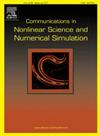Three-dimensional blade tip clearance response analysis of rotating shaft-disk-blade system with oblique cracked blade
IF 3.4
2区 数学
Q1 MATHEMATICS, APPLIED
Communications in Nonlinear Science and Numerical Simulation
Pub Date : 2025-05-01
DOI:10.1016/j.cnsns.2025.108932
引用次数: 0
Abstract
The rotating shaft-disk-blade system(RSDBS) is the crucial part of turbomachinery. Among RSDBS, crack is the most common failure mode of the blade. The crack propagation is affected by many factors such as stress state and environmental conditions, leading to the randomness of the crack angle. This study focuses on the dynamic modeling and analysis of the three-dimensional blade tip clearance (3D-BTC) response of the RSDBS with an oblique crack in the blade. Firstly, by reconstructing the geometrical correction factor and the stress intensity factor and based on the stress state at the crack section, an oblique cracked blade model is developed. This model enables the calculation of blade stiffness variations caused by cracks at different angles. Subsequently, Euler beam theory and the Lagrange equation are used to formulate a dynamic model of the RSDBS involving an oblique blade crack. The model comprehensively accounts for shaft bending, shaft torsion, radial deformation of the blade, flap-wise bending, and chordwise bending. The proposed model accuracy is validated by comparisons with finite element (FE) simulations and experimental data. Finally, simulations of the dynamic model are performed, and the time and frequency domain response of the 3D-BTC for the RSDBS are analyzed. The characterization indexes and their quantification methods for two types of oblique cracks in blades are proposed. Numerical studies demonstrate that the proposed indexes can accurately characterize the angle of cracks in rotating blades, rendering them suitable as crack monitoring indicators.
斜裂叶片转轴-盘-叶片系统叶尖间隙三维响应分析
旋转轴-盘-叶片系统(RSDBS)是叶轮机械的关键部件。在RSDBS中,裂纹是叶片最常见的失效形式。裂纹扩展受应力状态和环境条件等多种因素的影响,导致裂纹角度具有随机性。本文研究了含斜裂纹的RSDBS叶片三维叶尖间隙(3D-BTC)响应的动力学建模与分析。首先,通过重构几何修正因子和应力强度因子,基于裂纹截面处的应力状态,建立了斜裂纹叶片模型;该模型可以计算不同角度裂纹引起的叶片刚度变化。随后,利用欧拉梁理论和拉格朗日方程建立了考虑斜叶片裂纹的RSDBS的动力学模型。该模型综合考虑了轴弯曲、轴扭转、叶片径向变形、扑叶方向弯曲和弦向弯曲。通过与有限元仿真和实验数据的比较,验证了模型的精度。最后,对动态模型进行了仿真,分析了3D-BTC对RSDBS的时频响应。提出了两类叶片斜裂纹的表征指标及其量化方法。数值研究表明,所提指标能够准确表征旋转叶片裂纹角度,适合作为裂纹监测指标。
本文章由计算机程序翻译,如有差异,请以英文原文为准。
求助全文
约1分钟内获得全文
求助全文
来源期刊

Communications in Nonlinear Science and Numerical Simulation
MATHEMATICS, APPLIED-MATHEMATICS, INTERDISCIPLINARY APPLICATIONS
CiteScore
6.80
自引率
7.70%
发文量
378
审稿时长
78 days
期刊介绍:
The journal publishes original research findings on experimental observation, mathematical modeling, theoretical analysis and numerical simulation, for more accurate description, better prediction or novel application, of nonlinear phenomena in science and engineering. It offers a venue for researchers to make rapid exchange of ideas and techniques in nonlinear science and complexity.
The submission of manuscripts with cross-disciplinary approaches in nonlinear science and complexity is particularly encouraged.
Topics of interest:
Nonlinear differential or delay equations, Lie group analysis and asymptotic methods, Discontinuous systems, Fractals, Fractional calculus and dynamics, Nonlinear effects in quantum mechanics, Nonlinear stochastic processes, Experimental nonlinear science, Time-series and signal analysis, Computational methods and simulations in nonlinear science and engineering, Control of dynamical systems, Synchronization, Lyapunov analysis, High-dimensional chaos and turbulence, Chaos in Hamiltonian systems, Integrable systems and solitons, Collective behavior in many-body systems, Biological physics and networks, Nonlinear mechanical systems, Complex systems and complexity.
No length limitation for contributions is set, but only concisely written manuscripts are published. Brief papers are published on the basis of Rapid Communications. Discussions of previously published papers are welcome.
 求助内容:
求助内容: 应助结果提醒方式:
应助结果提醒方式:


